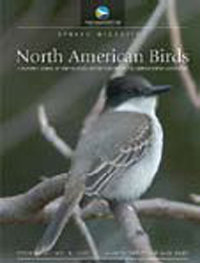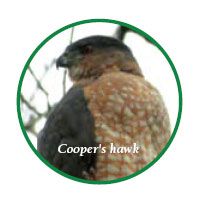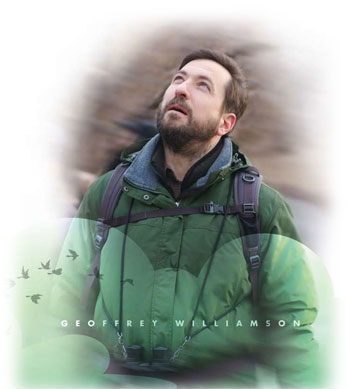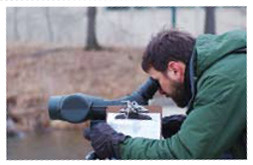
Urban bird watchers, take heart. The wonder and wildness of the natural world are right in Chicago, in those special areas where the sidewalks meet the soil, where the buildings yield to the trees. IIT Professor Geoffrey A. Williamson has visited many such special areas. One of his favorite avian-inspired nature memories is of a winter evening cross-country skiing with a friend at the Marovitz Golf Course in Lincoln Park.
“It was very picturesque that night. What had been a light drizzle had changed to snow as the temperature had just dropped below freezing. A fresh coating of pure white snow was everywhere and there was a coating of ice over all the trees,” says Williamson. “My friend and I had spotted what we thought might be a snowy owl on top of a spruce tree. We stopped skiing and looked at it in the faint light, trying to decide if it was an owl or maybe just a plastic bag. Finally, we decided it was a plastic bag. We then swished forward on our skis, making what really was a snowy owl take flight from the top of the tree, which then shook a little. The owl was totally silent, making no noise at all as it flapped off, the only sound being a cascade of tinkling as little ice crystals tumbled down through the spruce tree.”
Williamson is more than a casual bird watcher—he is a birder, someone who takes a more dedicated approach in their observations, engaging in the hobby at many different levels. He has seen nearly 650 different types of birds across the United States and has traveled to Peru and Costa Rica to observe the bird life in those countries. If you have gone on a Chicago Ornithological Society (COS) bird walk in Lincoln Park’s North Pond area, Williamson may have been your guide, as he has conducted more than 275 walks in the Chicago area and elsewhere.

Besides leading walks for the COS, Williamson has served as the group’s president and has been a member of its board as well as the board of the Illinois Ornithological Society; he is currently its membership secretary. He is the compiler, or organizer, of the Lisle-Arboretum Christmas Bird Count and is also co-editor for the Illinois and Indiana region of North American Birds, the journal of ornithological record published by the American Birding Association.
Birding has been a family affair for Williamson, who met his birder wife, Christine, when he moved from New York to Illinois and joined the COS. He became interested in birds at age 8 thanks to his parents, who gave him a field guide that he and his brother, Joel, consulted as they took their own bird walks around the pond next to their home. Williamson’s interest accompanied him to graduate school at Cornell University, where he began his birding activities in earnest—joining a bird club, meeting other birders, participating in bird counts and surveys, and traveling just to look at birds. When he is able, Williamson tries to piggyback birding side trips onto out-of-state work-related events he attends. At a spring research conference in Las Vegas, Williamson hopes to find the time to look for Le Conte’s thrasher, a bird of the desert Southwest that he has not yet seen.
Closer to home, Williamson has observed a type of predatory bird that has made IIT’s Main Campus its winter abode for the past several years: not Talon, the IIT Scarlet Hawk, but a Cooper’s hawk, and likely, more than one. Williamson saw it for the first time in the tree by George Segal’s Man on a Bench sculpture. “It is pretty unusual to have a bird like this roost in a spot that does get a fair bit of foot traffic going by,” he says, noting that the population of Cooper’s hawks is on the increase in Illinois. They can be seen across the state throughout the year, particularly during the spring and fall migrations.

“The bird seems to pay no heed to the various university folks who walk under its tree. Probably most of those people have no idea the bird is there,” he says. According to Williamson, the hawk seems to spend the day hunting for its typical diet of small birds, which it probably finds in the neighborhoods around Main Campus or along the Metra tracks, flying back to its tree roost for the night.
David Baker, vice president of IIT’s Department of External Affairs, has seen the campus hawk and is a birder who has learned much from his colleague. “He demonstrates a boundless enthusiasm, which rubs off on all of us in strange ways,” Baker says, as he recalls a December morning in 1998 when he and Humanities Professor Jack Snapper joined Williamson on an early morning “owling” expedition in the forest preserves near Argonne National Laboratory.
“In trying to see many different kinds of birds, you are led to visit a wide range of places that you might not go to otherwise.”
Although the temperature was only 4 degrees Fahrenheit, Williamson attempted to attract great horned and other varieties of owls the group was hoping to see using playback of tape-recorded owl calls. The extreme cold caused the recorder to fail, but the attempt was far from being unsuccessful, thanks to Williamson’s Plan B. “Undaunted, he then imitated the calls himself, yielding amazing return calls from the owls in the area around us,” explains Baker. “We covered the whole metropolitan area that morning and saw five different species of owls for our troubles.”
Williamson’s birding avocation and his science vocation seem to share common traits. “Every trip we have gone on together results in an email from him listing the exact number of species that we may have seen that day,” says Baker. “Geoff applies the same energy and precision to birding as he does to his academic and research work in electrical engineering.” Williamson, who investigates system and signal analysis in various applications through the Department of Electrical and Computer Engineering, is currently collaborating with two other institutions on a project studying the causes of kidney damage from high blood pressure and is focusing his efforts on the dynamic response of the microvasculature to blood pressure changes.

While Williamson brings an energy and precision to his birding, birding brings to Williamson a rewarding way to experience the natural world. He explains that a reason why birding is so rewarding is that both seeing and identifying a particular bird can be quite challenging. But it is a challenge Williamson relishes. “In trying to see many different kinds of birds, you are led to visit a wide range of places that you might not go to otherwise.” For Williamson, this may mean a trip to as yet unvisited corners of the country in search of his 651st bird, while for others it may be as simple as standing at the base of the Man on a Bench tree and looking up.
Photos: Bonnie Robinson